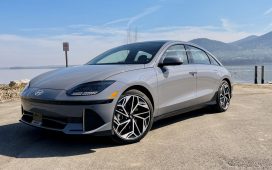General Motors announced that all of its electric vehicles will have bidirectional vehicle-to-home (V2H) charging capabilities by model year 2026.
The first vehicle to be released with bidirectional V2H charging will be the 2024 Chevy Silverado EV, followed by the 2024 GMC Sierra EV Denali Edition 1, 2024 Chevy Blazer EV, 2024 Chevy Equinox EV, 2024 Cadillac Lyriq, and the upcoming Cadillac Escalade IQ (which is getting a proper debut later this week).
The revived Chevy Bolt with Ultium powertrain was not included on the official list, but Derek Sequeira, director for EV ecosystems at GM, said that, as a future Ultium model, it would very likely include bidirectional charging as well.
Adding bidirectional charging powers will be “a game changer,” Sequeira said, “because it gives more customers the ability to unlock the value of their electric vehicle.”
“It gives more customers the ability to unlock the value of their electric vehicle”
Bidirectional charging works exactly like it sounds: with unidirectional (one-way) EV chargers, electricity flows from the electric grid into the electric vehicle; with bidirectional (two-way) EV chargers, electricity can flow both ways.
The idea is to use bidirectional charging equipment to push and pull energy from electric vehicles at any given time. In essence, it treats high-capacity lithium-ion batteries not only as tools to power EVs but also as backup storage cells to charge other electric devices, an entire home, or even to send power to the electrical grid for possible energy savings.
And in case you were wondering whether you had the right equipment to connect your electric truck to your home, GM has you covered there, too. GM Energy, the automaker’s energy spinoff, recently announced a suite of home products, including two Ultium Home kits to enable V2H charging between an EV and a home. GM says prices will be available for these products later this year.
The Chevy Silverado EV will be the first vehicle from GM to feature the new bidirectional charging capabilities
Heatwaves as a result of climate change are putting more stress on electric grids. The Energy Information Administration recently warned that two-thirds of North America could face electricity shortages when temperatures spike over the summer. And indeed, July was the hottest month ever recorded.
Ford’s been getting a lot of attention for the F-150 Lightning’s bidirectional charging capabilities, and GM clearly thinks its EVs deserve some, too. The Chevy Silverado EV will be the first vehicle from GM to feature the new bidirectional charging capabilities. When it was first unveiled in 2021, Chevy said the electric truck would have up to 10.2kW of offboard energy on the WT (work truck) RST trims. That’s more than the F-150 Lightning’s 9.6kW of offboard charging for top trim models.
An increasing number of EVs are coming out that support bidirectional charging. In addition to the F-150 Lightning, there’s also the Hyundai Ioniq 5 and Kia EV6, the upcoming Volvo EX90, and even the lowly Nissan Leaf. Tesla will likely bring the technology to its lineup by 2025.
Tesla CEO Elon Musk has criticized bidirectional charging as useless without stationary power storage like home batteries. And indeed, GM Energy aims to sell home batteries as part of its home kits so vehicle owners don’t have to worry about their home’s lights going off when they unplug their cars.
Sequeira said that bidirectional charging has only recently caught on because automakers were wary of stoking fears about EVs as detrimental to electrical grids. Those fears continue to resonate, but Sequeira says customers are starting to see the value in EVs as “virtual power plants,” storing energy that can supplement the grid during times of peak demand.
“I think a lot of the fear from before is now starting to subside a bit,” he said. “And we’re now at a point where I think utilities are on the same page as OEMs.”











